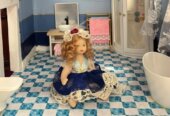
Curious and intelligent, deer farming has an element of psychology to it, according to the manager of Raroa Red Deer Stud, Bill Robinson.
Sitting on 227 hectares just out of Cambridge, the Raroa Red Deer Stud has been producing venison, velvet and trophy deer for the past 30 years. At the helm for 21 of those years is manager Bill Robinson, who will be hanging up his boots next year and retiring into Cambridge – time for a well-earned rest. The property on Fergusson Gully Rd was a sheep and beef farm until it was converted into a deer farm back in 1988, with the accompanying six-foot fences and custom-built deer shed installed. And long races with sharp right-angled turns put in to cater to the deer’s tendency to run quickly, then zig-zagging to escape.

Raroa Red Deer Stud manager Bill Robinson and a deer skull, which shows the pedicle that acts similar to a nail bed, growing a number of sets of antlers over the stag’s life.
“There’s a lot of psychology in deer farming,” Bill explained. The 70s and 80s was a boom time for the deer industry, Bill continued, with tax incentives from successive governments intent on diversifying the country’s farming industry. Fast-forward thirty years and Bill reckons around 2000 deer farms in New Zealand are now without deer on them. “Those left in the industry are passionate about it,” he said, explaining that there have been a lot of dips over the years.
The overseas demand for velvet has kept the industry going throughout, with New Zealand producing half of the global supply. It’s mostly used in Asian medicine and health care products, Bill explained, with the term referring to the stick of velvet not just the furry coating on the outside of it. “It feels like the velvet curtains,” he laughed, “but it’s not”. And the international demand for New Zealand venison outstrips current supply, Bill said. “That’s why venison is expensive in the New Zealand market,” he explained, adding that the price it fetches overseas makes it more worthwhile for farmers to export the meat than sell it domestically.
With 650 stags and 500 hinds on the Raroa stud near Karapiro, the red deer there are bred for different purposes. Over the past five or six years, Bill said the stud has moved back to velvet, with venison and trophy animals a by-product of production. The stud now favours animals with thick antlers which are well-suited for velvet production, with bigger animals suitable for venison and deer with a multi-pointed sire most likely producing trophy animals.

stick of velvet with a bulbous tip that the sharp spikes would emerge from if it was not cut.
The velvet herd stands at 480 stags, with Raroa’s velvet adding to the 725 tons of velvet the country produces each year – up from 400 tons just six years ago. Raroa is a member of a co-operative, which sees the velvet sent to Christchurch along with velvet from other farms around the country and graded like with like. It used to be batched and sold in massive quantities by tender, Bill said, explaining that the process has changed over recent years and now the product is marketed properly and fetches a higher price for farmers.
Deer farming pulled in an estimated revenue last year of $266M last year. Of that, venison made up the bulk with $165M earned, while velvet brought in $59M and hides, leather and co-products such as bones and fat making up the remaining $42M. Proof that tax incentives aside, there is still money to be made in the deer industry.








